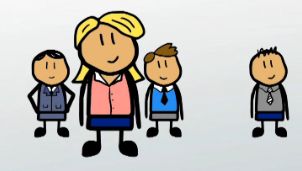Bureaucracy: Max Weber's Theory of Impersonal Management
After you watch the video and know the material, click HERE for the quiz.
At a time when organizations were run like families, Max Weber looked for ways to bring a more formalized structure to organizations. Weber created the idea of bureaucratic management where organizations are more authoritative, rigid and structured. This lesson will describe the development of bureaucracy and common characteristics of bureaucratic organizations.
Note: for the purposes of this video, the instructor has chosen to use the American pronunciation of Max Weber's name.
The Development of Bureaucracy
In the late 1800s, Max Weber criticized organizations for running their businesses like a family, or what some of us might refer to as 'mom and pop'. Weber believed this informal organization of supervisors and employees inhibited the potential success of a company because power was misplaced. He felt that employees were loyal to their bosses and not to the organization.
 |
Characteristics of Bureaucratic Organizations
A well-defined formal hierarchy and chain of command distinguishes the level of authority within an organization. Individuals who hold higher positions will supervise and direct lower positions within the hierarchy. For example, Megan the Manager supervises a team of four sales representatives. Megan's position within the organization as a supervisor gives her authority over those four sales representatives to direct and control their actions to ensure organizational goals are met.
Management by rules and regulations provides a set of standard operating procedures that facilitate consistency in both organizational and management practices. For example, when an employee is sick and cannot make it into work that day, he or she must call out to their direct supervisor. If one of Megan's sales reps is sick, they are expected to call her directly to inform her of their absence. Any employee who fails to do this will be subject to termination. All of Megan's employees are expected to follow this rule, and Megan is expected to enforce this rule equally among her employees.
 |
Division of labor and work specialization are used to align employees with their organizational tasks. This way, an employee will work on things with which he or she has experience and knows how to do well. For example, let's say two of Megan's sales reps are experienced in selling products to vendors in the western region of the state due to their extensive experience working in that area. Megan would then put those two employees in charge of that specific region and would place the other two sales reps in the eastern region.
Managers should maintain an impersonal relationship with employees to promote fair and equal treatment of all employees so that unbiased decisions can be made. This is not to say that Megan should not be friendly with her employees; rather, Megan should be professionally friendly with her employees and work to maintain a clear separation between business and pleasure. For example, Megan should refrain from spending time outside of work with her employees. While it is acceptable for the four sales reps to meet up after work for happy hour and have a drink, Megan should excuse herself from participating in such an occasion.
Competence, not personality, is the basis for job appointment. An employee should be chosen, placed and promoted within an organization based on his or her level of experience and competency to perform the job. For example, if Megan found room for a fifth sale rep on her team, she should look to recruit and place a new sales rep based on a person's ability to successfully perform the duties of the position. Hiring someone she is friends with, for example, would be a poor decision by Megan, as there is no guarantee her friend is a competent sales rep.
 |
Lesson Summary
To review, Max Weber disliked the idea of managing an organization informally. He believed in a much more rigid, formalized structure known as a bureaucracy. The characteristics of a bureaucracy include: 1) A well-defined formal hierarchy and chain of command; 2) Management by rules and regulations; 3) Division of labor and work specialization; 4) Managers should maintain an impersonal relationship with employees; 5) Competence, not personality, is the basis for job appointment and 6) Formal written records.